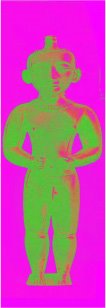DSPR12B - PRINT FUNDAMENTALS - TASK 2 : CUVDES01A

This task requires that we research three resources on Colour Theory. Two have been chosen from the Ithaca TAFE Library (1 x Book + 1 x Magazine) and one from the web.
Magazine: Computer Arts Projects - July 2006
This issue is dedicated to Print design and colour usage . It includes informative and practical advice from the experts on successful colours and finishes for specific target audiences and for specific project concepts. This magazine also provides the reader with a free CMYK colour chart and a creative tutorials booklet with 40 pages of tuts and fantastic ideas and inspirational images to help the budding Graphic Designer.
Book: Mix & Max Designers Colours by David Bann
This book is a Designers handbook of colour swatches for choosing and specifying tints for use in the 4-colour print process. The 600 swatches display the percentage breakdown for each and can be easily compared with the other colours and their tint properties. These colours were selected to best represent a broad range of usage for all forms of print media. All colours in this informative and practical book were produced using process colour tints and are compatible with the 4 colour print process. This book delivers a short but comprehensive section on colour theory, specifically on the relationship beween Subtractive and Additive colours and their application from screen to print on various types of paper.
Website: Colour Matters: http://www.colormatters.com/colortheory.html
This site covers the definitions and concepts and design applications in regards to colour theory. The basic concepts of colour are introduced using a colour wheel in full and then split into Primary, Secondary and Tertiary, Analogous and Complimentary as shown in the below figures. Colour is described in a more traditional sense as these colours originally represented pigments. However we now have many variations of the Colour Wheel given the advancements in computer and print technology. Colour Matters also looks athe psychology of colour in terms of Harmony a balance in the visual experience for the viewer of the design.
COLOUR WHEEL, PRIMARY, SECONDARY & TERTIARY COLOUR WHEELS.
COOL QUOTE: "... extreme unity leads to under-stimulation, extreme complexity leads to over-stimulation. Harmony is a dynamic equilibrium."
http://www.colormatters.com/colortheory.html




SET OF STATUES - BY KYLEIGH SHARPE





0 Comments:
Post a Comment
Subscribe to Post Comments [Atom]
<< Home